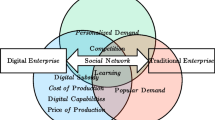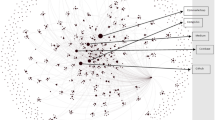Abstract
Nowadays, Internet financial products, like Internet banking service and e-payment, have permeated into every corner of civil life in China. Via the Internet and media, consumers can obtain big data and information of financial products. Consumer big data analytics capabilities directly affect consumers’ cognition and thus affect their adoption of Internet financial products. Upon this background, this paper aims to study the diffusion of Internet financial products in a big data environment based on consumer analytics capabilities. First, in light of the consumer decision-making mechanism, we build a random threshold model for the diffusion of Internet financial products. Next, we explore the impact of consumer big data analysis capabilities on the diffusion of Internet financial products under different proportion of initial adopter and network densities in a specific social network topology. The simulation result shows that the consumer big data analytics capabilities have a significant impact on the speed and depth of the diffusion of Internet financial products. However, when proportion of initial adopter and network density reaches a certain value, the impact of consumer big data analysis ability on diffusion speed and depth has decreased. This study has a guiding significance for new strategies of Internet financial products promotion.





Similar content being viewed by others
Change history
29 November 2022
This article has been retracted. Please see the Retraction Notice for more detail: https://doi.org/10.1007/s10257-022-00606-y
References
Agarwal S et al (2014) Regulating consumer financial products: evidence from credit cards. Q J Econ 130(1):111–164
Barkhordari M et al (2017) Factors influencing adoption of e-payment systems: an empirical study on Iranian customers. IseB 15(1):89–116
Bonabeau E (2002) Agent-based modeling: methods and techniques for simulating human systems. Proc Natl Acad Sci 99(suppl 3):7280–7287
Chen X, Jin F, Zhang Q et al (2016) Are investors rational or perceptual in P2P lending? IseB 14(4):921–944
Choudrie J, Junior CO, Mckenna B, Richter S (2018) Understanding and conceptualising the adoption, use and diffusion of mobile banking in older adults: a research agenda and conceptual framework. J Bus Res 88:449–465
Ciaian P, Rajcaniova M (2016) The digital agenda of virtual currencies: can BitCoin become a global currency? IseB 14(4):883–919
Fan S, Lau RY, Leon Zhao J (2015) Demystifying big data analytics for business intelligence through the lens of marketing mix. Big Data Res 2(1):28–32
Fernández-Márquez CM, Vázquez FJ (2018) How information and communication technology affects decision-making on innovation diffusion: an agent-based modelling approach. Intell Syst Account Finance Manag 25(3):124–133
Kalia R, Lippmann C, Lui H et al (2014) The era of big data. Md Med 15(3):19–21
Kim C et al (2010) “An empirical study of customers’ perceptions of security and trust in e-payment systems. Electron Commer Res Appl 9(1):84–95
Lee E, Kwon K, Schumann DW (2005) Segmenting the non-adopter category in the diffusion of internet banking. Int J Bank Mark 23(5):414–437
Lim S, Jung I, Lee S et al (2015) Analysis of information diffusion for threshold models on arbitrary networks. Eur Phys J B 88(8):201
Lin F-T, Wu H-Y, Tran TNN (2015) Internet banking adoption in a developing country: an empirical study in Vietnam. IseB 13(2):267–287
Loebbecke C, Picot A (2015) Reflections on societal and business model transformation arising from digitization and big data analytics: a research agenda. J Strateg Inf Syst 24(3):149–157
Luo B, Lin Z (2013) A decision tree model for herd behavior and empirical evidence from the online P2P lending market. IseB 11(1):141–160
McAfee A et al (2012) Big data: the management revolution. Harvard Bus Rev 90(10):60–68
Merigó JM, Gil-Lafuente AM (2010) New decision-making techniques and their application in the selection of financial products. Inf Sci 180(11):2085–2094
Pappas IO, Mikalef P, Giannakos MN et al (2018) Big data and business analytics ecosystems: paving the way towards digital transformation and sustainable societies. IseB 16(3):479–491
Paulin J, Calinescu A, Wooldridge M (2018) Agent-Based modeling for complex financial systems. IEEE Intell Syst 33(2):74–82
Presthus W, O’Malley NO (2017) Motivations and barriers for end-user adoption of bitcoin as digital currency. Proc Comput Sci 121:89–97
Prince JT, Simon DH (2009) Has the Internet accelerated the diffusion of new products? Res Policy 38(8):1269–1277
Provost F, Fawcett T (2013) Data science and its relationship to big data and data-driven decision making. Big data 1(1):51–59
Rieger MO (2012) Why do investors buy bad financial products? probability misestimation and preferences in financial investment decision. J Behav Finance 13(2):108–118
Tan M, Teo TSH (2000) Factors influencing the adoption of internet banking. J AIS 1(1es):1–42
Yuen Y, Yeow P, Lim N et al (2010) Internet banking adoption: comparing developed and developing countries. J Comput Inf Syst 51(1):52–61
Zhou R, Pham MT (2004) Promotion and prevention across mental accounts: when financial products dictate consumers & investment goals. J Consumer Res 31(1):125–135
Acknowledgements
The authors acknowledge the Fundamental Research Funds for the Central Universities, Donghua University (Grant: CUSF-DH-D-2018055).
Author information
Authors and Affiliations
Corresponding author
Additional information
This article has been retracted. Please see the retraction notice for more detail: https://doi.org/10.1007/s10257-022-00606-y
Rights and permissions
Springer Nature or its licensor (e.g. a society or other partner) holds exclusive rights to this article under a publishing agreement with the author(s) or other rightsholder(s); author self-archiving of the accepted manuscript version of this article is solely governed by the terms of such publishing agreement and applicable law.
About this article
Cite this article
Zhang, J., Zhu, S., Yan, W. et al. RETRACTED ARTICLE: The construction and simulation of internet financial product diffusion model based on complex network and consumer decision-making mechanism. Inf Syst E-Bus Manage 18, 545–555 (2020). https://doi.org/10.1007/s10257-018-0384-0
Received:
Revised:
Accepted:
Published:
Issue Date:
DOI: https://doi.org/10.1007/s10257-018-0384-0




